MARY STONE,
of Hill House, Leckhampton
Mary Stone, purchased Hill House on Leckhampton Hill in 1959 and it has been her home for over 50 years.
Stoney, which is the name everybody knows her by, is a true English character, Educated, commanding, a spinster animal lover, a foster mother for over 30 years who has amassed a vast network of friends and acquaintances - 'a queen of her world', this is her story.
Her early years
For the history of her family background, please refer to harvington/houses, under the property 'Dalkeith'. Mary Stone was born in Denmark Road, Gloucester 21st July 1928. Her mother Honor Stewart Clarke, died when she was six. About the same time, her father William Stone, retired as a Bank Manager and moved to a house in Andoversford. Her brother Paul was born in 1927.

Stoney with her brother Paul at Owdeswell.
She went to a number of schools, the first being what is now the Grammar School, Denmark Road, Gloucester (Kindergarten). She also went to The Ladies College, Cheltenham, Darley House School, Cheltenham, Charlton Park Convent School and Queenswood School at Colwell near Malvern.

Stoney on bike at Glengorse circa 1948.
In her late teens she worked as an Assistant Matron at a private school in Malvern Wells, at Emscote Lawn School in Warwick and a couple of other schools. She then became an assistant matron at Glengorse School, Battle, Sussex, where she also taught drawing to all the students. Later she taught at Heathfield School, Sussex and Ayreh House School, Hove, a Jewish school. She then went to the Teacher Training college, Chichester (now the University of Sussex), and taught in a school in Newport Road, Aldershot.
From the 1980's onwards, she would help at Coberley Primary School by taking on Children who needed a bit of a boost and would also have children who visited her at home for sessions on an hourly basis. Her teaching very often involved improvised board games with an emphasis on either numbers or letters. She used these games to gain the child's enthusiasm to learn. She continued to help children in this way until about 2011.
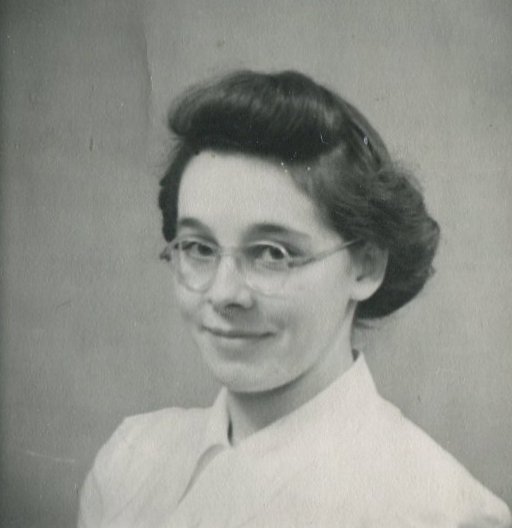
Mary Stone.
There was an incident when Stoney was about four years old. Her father was driving their car along the Cheltenham to Stroud road, past Prinknash Abbey and was in the act of turning left towards the village of Cranham when a sports car crashed into the back of them and turned their car over. This would have been circa 1932 and the roads had very few cars on them. At the time her father had his arm sticking outside his driving window while using the then usual hand motion to turn left. Stoney, her mother and brother Paul were all in the back seat and as the car turned onto its off side, mother and brother ended up on top of Stoney while at the same time her father's arm was crushed under the car. She remembers people from the nearby house coming out to help and calling for an ambulance to take her father to Hospital. Her father's arm was never the same again and showed a marked kink where the bone had been crushed just above the wrist. Years later she would note that when her father became angry or agitated, he would wave his twisted arm in the air. This happened on one particular occasion when they were at table and Blanche, her stepmother, said they could not have more bread because of the expense and her father insisted that they could.

William Stone in centre with a family called McDougall.
When stony was about seven, her father used to drive her in the mornings to The Ladies College where she attended school. One day they picked up a class mate of Stoney's called Gill, along with Gill's great aunt called Blanche. This became a habit and her father and Blanche got to know each other. One day her father asked Stoney whether she would mind if he married Blanche, although she did not like either Blanche or Gill, she said she didn't mind. Having lost her mother some years before she believed her father wanted someone to help look after Stoney and her brother Paul.
Blanche the stepmother
Blanche Susannah Lloyd (born Cheltenham 1884), was a spinster without children. She lived at 7 Old Bath Road with Gill and a sister called Ann, Stoney remembered Ann as an elderly lady with one eye and one tooth. The mother of Gill was Violet G M (Gwen) Lloyd, Blanche's niece. She had married in Bromley in 1926 to Sidney Arthur Billes who lived in India and had had two daughters Gill and Eve. Gwen's husband died in Calcutta in 1931, the consequence being that Gill went to live with her great aunt Blanche while Eve stayed with her grandparents in Norwich. Gwen the mother later joined Eve in Norwich followed by Gill. Gwen remarried in 1935 her second husband being Warrant Officer Joseph James Tucker. |
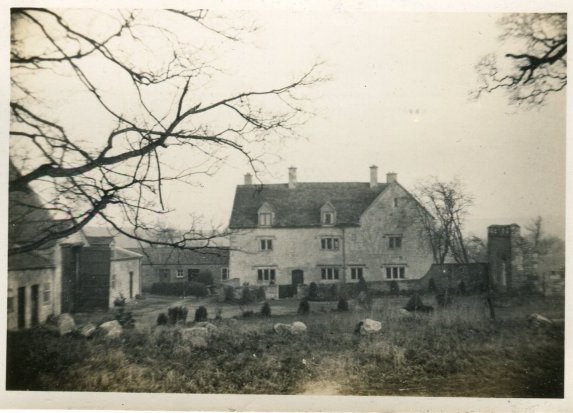
Owdeswell Manor circa 1937. |
|
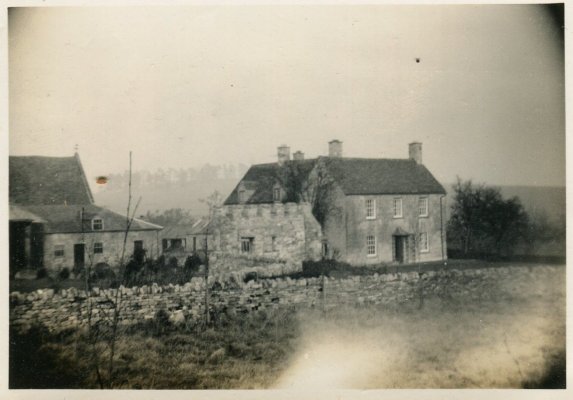
Owdeswell Manor circa 1937.
|
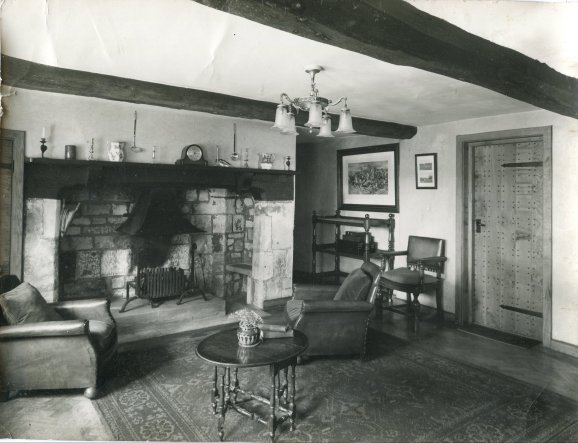
Owdeswell Manor circa 1937. |
|
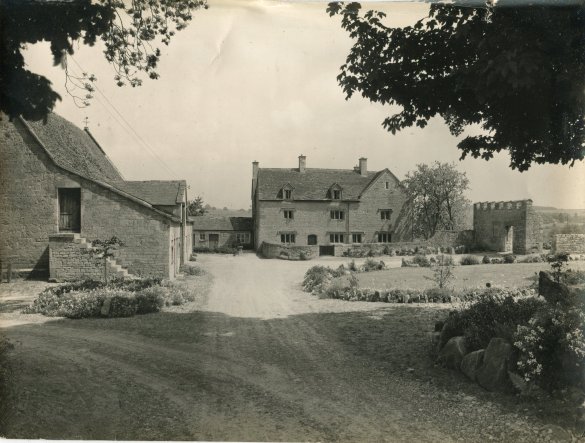
Owdeswell Manor circa 1937.
|

Owdeswell Manor circa 1937.
At some stage Stoney's father bought Owdeswell Manor near Andoversford and lived there with Blanche, Stoney, Paul and Gill. However, Blanche didn't like the house considering it to be too far out of town, so they moved back to Cheltenham and bought a house called Wingfield in Western Road. They lived there with Blanche, her sister Ann, a dog and Stoney, along with Paul, Gill and Eve in the holidays. The 'family' moved again when Stoney's father bought 100 (Allipore House) Evesham Road.
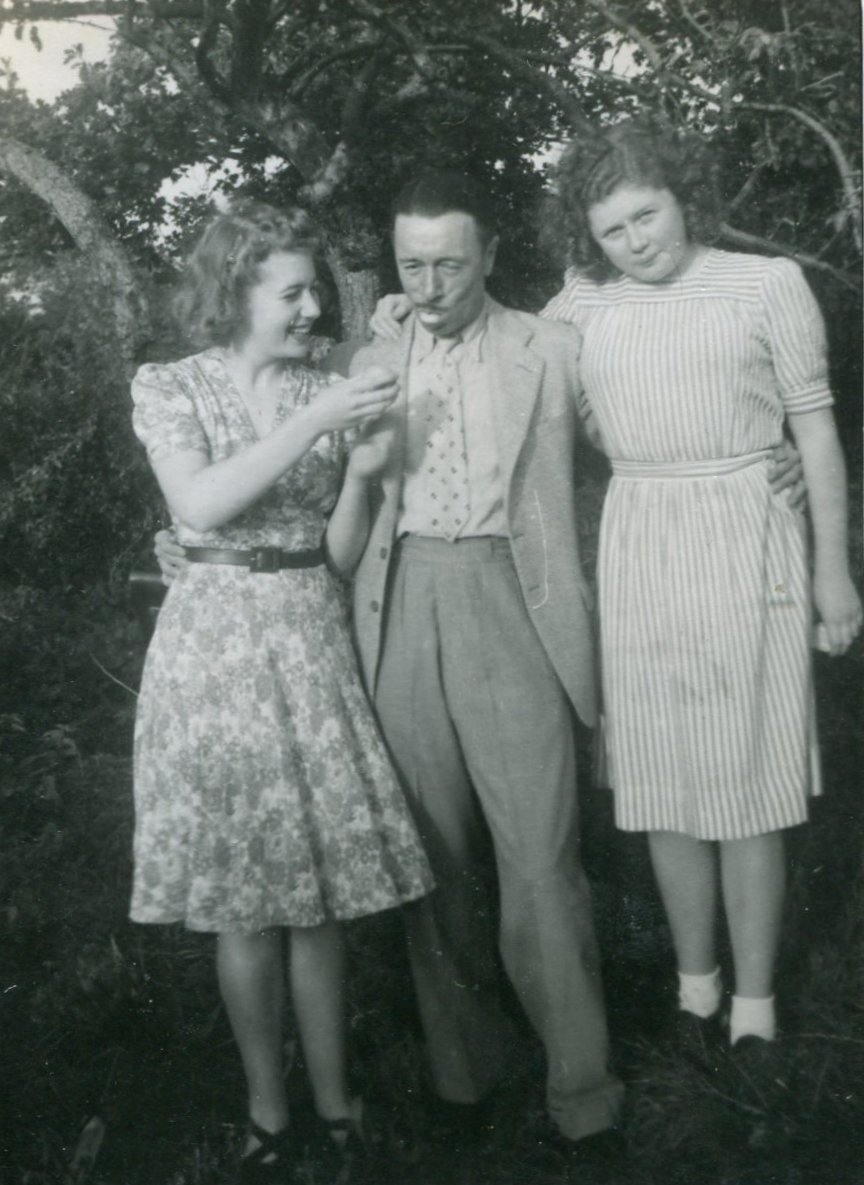
Gill and Eve eating apples with their step father
at the New Inn Rockland St Mary's, Sept. 1946.
Steventon, Berkshire
At this time, her father's sister Gertrude Booker, who lived in an old Priory in Steventon, Oxfordshire was becoming frail. Her husband Reginald had died and William, her father, had promised his sister that he would look after her, so he sold up in Cheltenham and moved with Blanche to Steventon while Blanche's sister Ann moved back to Old Bath Road where Blanche soon joined her as she could not stand living in Steventon. Stony didn't think her father and Blanche were happy together. Blanche hated being in Steventon and Stoney remembered that at this time Blanche spoke to Stoney about it. This was the first time that Stoney would remember her stepmother conversing with her. Stoney was quiet as a child and was not good at expressing herself.
The Priory was sold and William and Gertrude moved into a small house in Stock Lane in the same village. About 1958 Gertrude had to go into hospital and died there aged 88. Stoney's father then became ill and her brother Paul transferred him to a small nursing home in Winchcombe, run by a Mrs Pettigrew. Her father died in the early 1960's.
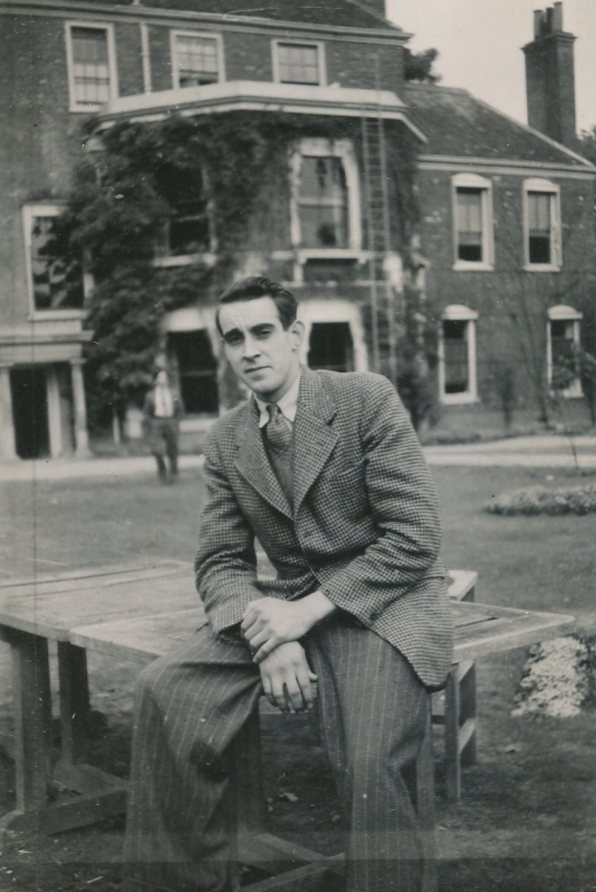
Paul Stone.
Blanche's sister Ann later died and Blanche was still living in Old Bath Road in 1960. Gill emigrated to South Africa and married. She later moved to Brookfield, Queensland, Australia where she had a large family and is still alive (2012) and Stoney exchanges letters.
As will be seen below, Stoney is an animal lover. Therefore for obvious reasons she was not a traveller, and apart from an occasional day out and two short holidays back to the area of her old retreat in Sussex, she only had only two holidays. One was when she was 16 years old. She and her cousin Ruth Stone, went to the Lake District for several days, staying in a youth hostel while cycled around the area and also walked up either green or Great Gable. The other was a cycling holiday in the West Country with a Scandinavian girl called Gunnel.
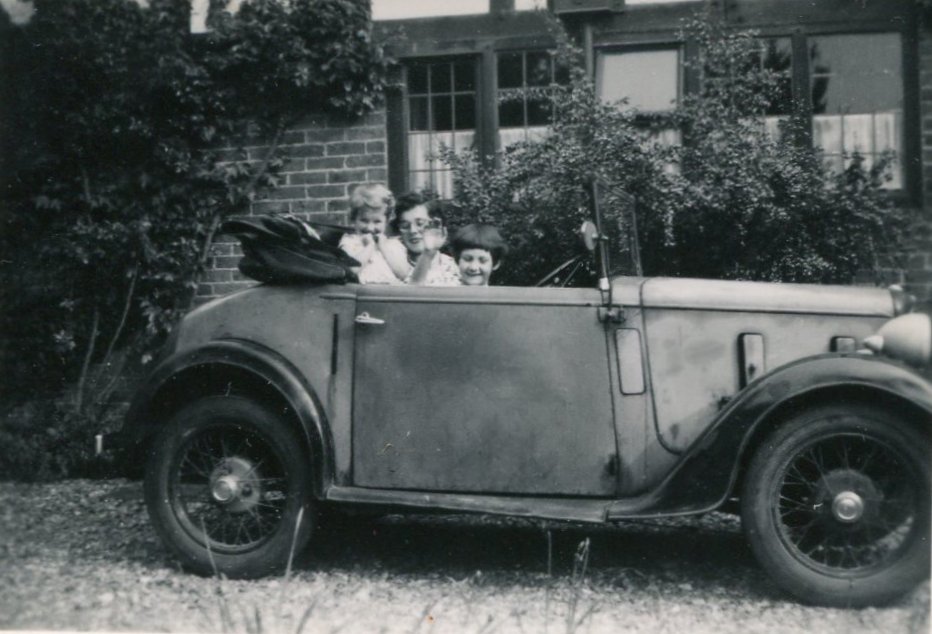
Stoney's first car, an Austin 7 tourer at Boreham Street.
In about 1952, Stoney had her first car in Hastings, an Austin 7 tourer. She had this car for several years after which she bought an Austin of England car.
Stoney at Hill House
As stated earlier, Stoney bought Hill House and moved in on 1st December 1959. The House was built in the 1840's being one of the first properties on the Hill. It is set within a large garden and woodland and used to possess a stable block and gardener's cottage. Fairly early on both the stable block and the cottage were sold off and are now large houses in their own right.
Stoney had bought the house with the intention of setting up a guest house for children who had nowhere to go during the summer holidays. For the next fifty three years Hill House has been her home. During that time she has had over 200 hundred children plus many dozens of tenants. The house was used firstly as a foster home and bedsits, and from the 1980's as apartments when the house was converted into six flats plus her own quarters.
|
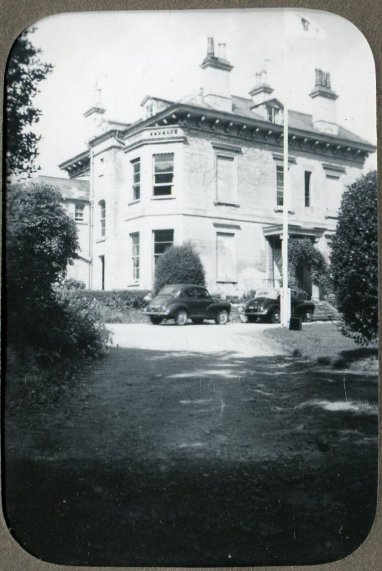
Hill House circa 1960. |
|
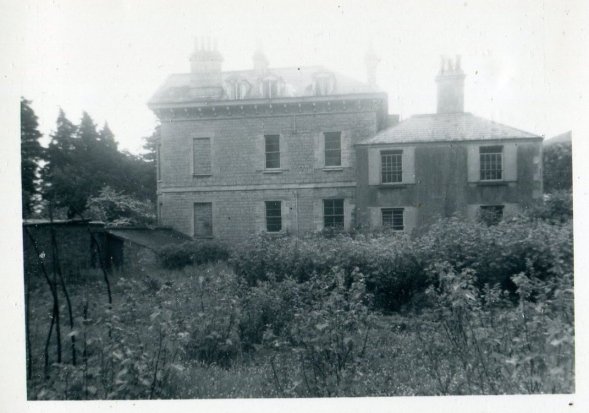
Hill house circa 1960. |
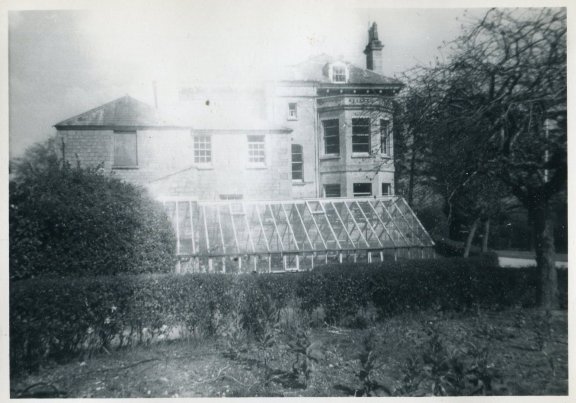
Grape vine at Hill House circa 1960. |
|
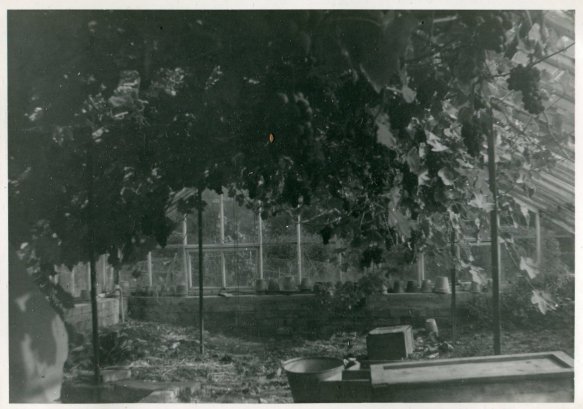
Conservatory at Hill House circa 1960. |
|
Stoney came to Hill House with her mother's old piano, a small armchair and two beds. Up to then Hill House had been a grand gentleman's residence on the outskirts of town with large gardens and woodland, lawns, tennis court, very large vegetable garden, orchard, greenhouse, stables and gardener's cottage.
To have help running the house, she contacted somebody in Gloucester and met Margaret Airlie in Cathedral Close. Margaret was an unmarried mother with a 14 month old boy called Peter Stuart although known as Stuart, his father was never mentioned. She needed money and a home so they both agreed that Margaret should move in, initially to help Stoney run the house as a guest house for children. Margaret's history was a bit vague but apparently her parents ran a grocers shop in Bisley near Stroud. Their relationship was at times fraught as Stoney was quite a strong character while Margaret was moody and was described as strange.
Margaret had apparently been attached to the Territorial Army and it was during this time that Stuart was conceived. She was not a good mother to Stuart and often while he was an infant would leave him alone for many hours at the top of the house in a state of uncleanliness and hunger. Stoney would attempt to offer him food but this was frowned upon. He was eventually boarded out to a school near London by the Social Services.
Margaret later befriended a man from Jackson Stops in Cirencester who lived in Northleach and acted as his chauffeur owing to his problem with drink. Meanwhile the relationship between Stoney and Margaret had deteriorated and Margaret finally moved out in about 1969 and went to work for Sketchleys the dry cleaners, taking Stuart with her. They lived in a number of flats in the Cheltenham and Gloucester area including an apartment above the fish & chip shop in Bishop's Cleeve, after which she moved to Scotland without Stuart. Stuart kept in touch with Stoney and would visit occasionally but made no attempt to contact his mother. He worked for a local coach company for some years and later transferred himself down to Newport in Monmouthshire. He became ill in his 30's but would not contact his mother and Stoney was informed by his friend Nigel that he had died of a brain tumour. Margaret came down for Stuart's funeral and stayed at Stoney's for a week, then returned to Scotland and eventually died there in about 1989.
Stoney by name:
Mrs Winifred (Freddie) Gabb was the first person to call Mary Stone by the name 'Stoney'. Mrs Gabb's mother lived at Daisy Bank House and was known as 'Ma'. Along with Ma was Mrs Gabb's sister. There was also a brother called St John. Mrs Gabb didn't get on with her sister at Daisy Bank house, so moved into a room at the top of Hill House. She later moved down to the old dining room on the ground floor as she was suffering from MS. She was married to Mr Theodore (Theo) Gabb who was a driving instructor and had a very bad temper. They had married in Cheltenham in 1943, she being Winifred H St John Wilding. They had a daughter called Gabrielle, who was born in Cheltenham in 1949 who also lived in Daisy Bank House. They did not live together but he would often visit his wife to take their dog for a walk and would then leave in a fury over something or the other.
Ma later died and Mrs Gabb's sister went to live in Sheffield. Their brother ordered Mrs Gabb to go and live with her sister in Sheffield as he wanted them to be together to make it easier for him to visit them. She was then moved into a home where she later died. Before becomming too ill, she used to work nights at Salterley Grange, which was then a hospice for cancer patients.
The Animals
Stoney is exceptionally fond of animals and over the years has always treated them with the greatest respect. Once she had moved to Hill House, her animal collection gradually grew. She had her first pet in 1954 while she was living in East Hoathley in Sussex as a teacher in a local school. It was a Seal point Siamese cat called Phouquey.
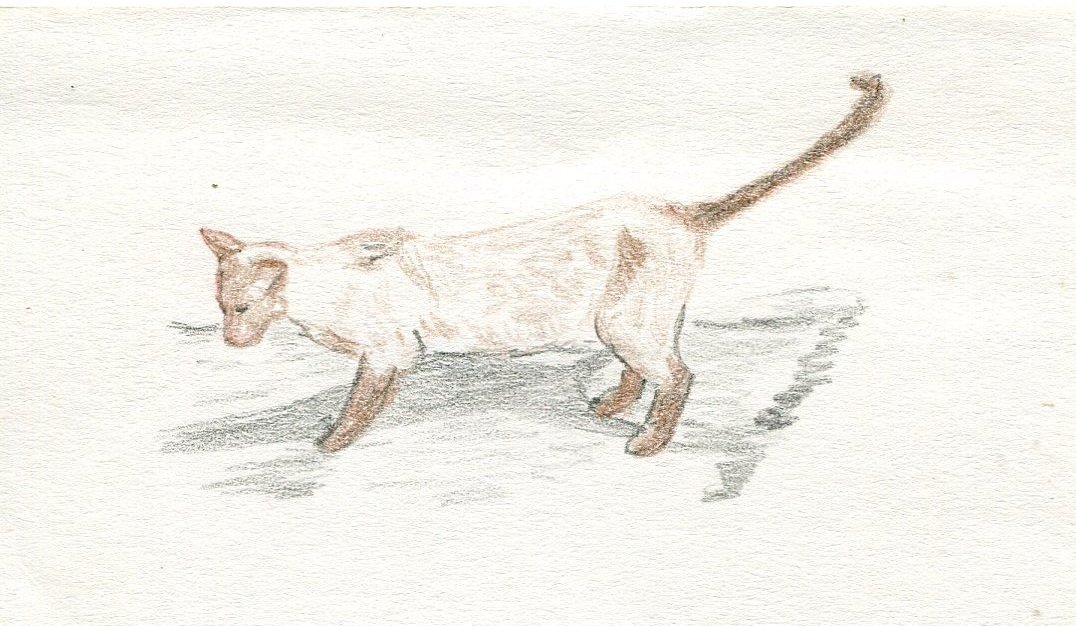
Phouquey by Stoney
Phouquey came with Stoney to Hill House along with a little tabby called Biffy, short for Tabifur. Almost immediately she acquired a Golden Retriever puppy, who she named Misty. For her new friend Margaret she bought a cat called Mistletoe (Tosey).
A common theme throughout her life as pet owner was the naming of her animals. She would never use ordinary names and, if she had a chance, would change them. The name changes were often quite convoluting. Examples are: Prils the fox, which came to her as April. April became Prila but this caused a problem when she shouted out 'Prila' as the dog Kena (called so because it came from the vet McKenna) would run out of the room thinking that it was being ticked off. Dogs apparently only hear the ending of their name. Stoney changed the name to Prils, which solved the problem. Another example was 'Twankas': a (T)om which was (w)hite, (a)ge (n)ot (k)nown, (a)rrived (S)eptember. Wignor, a cat with great character & intelligence, came from between Wiggington Heath and Hook Norton so was called Wignor. I call him Wiggers and he calls me Jullers!
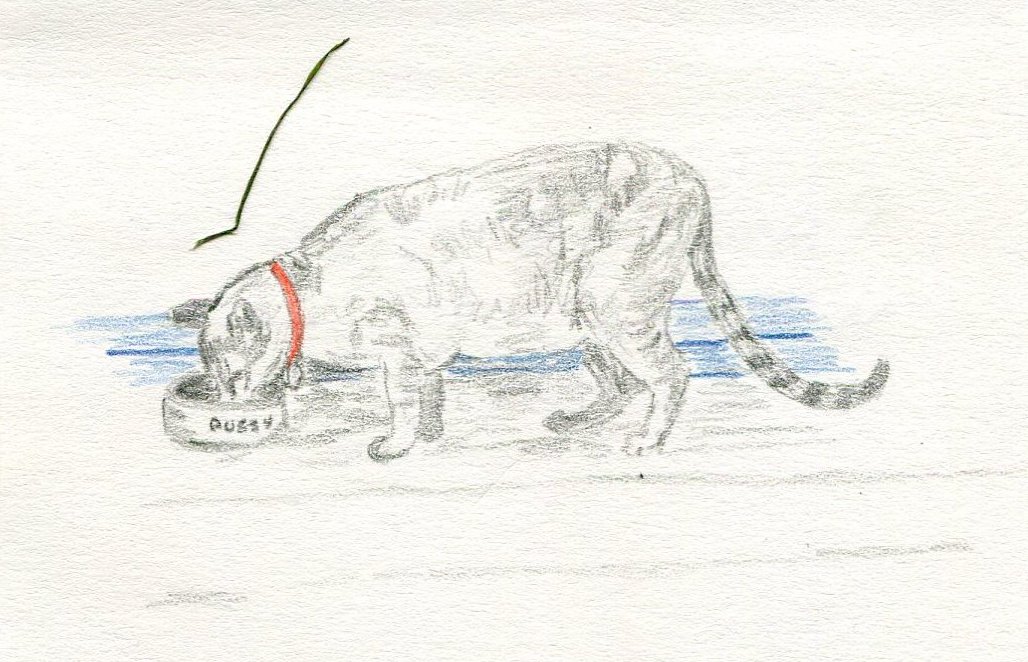
Passo or Pasda, twin kittens of Shaun & Penny By Stoney
Stoney decided to breed cats, so the next cats to arrive on the scene were two Seal point Siamese and a blue Burmese.
The first donkey to arrive was a grey female, whom she called Mena, which gave much happiness to the children. Later, another donkey with a foal arrived, they were owned by a lady vet called Judy. I remember the donkey when I first visited Hill House in the mid to late 1970's. I visited Janet Vizard who lived in one of the top rooms, at the time she was a member, as I was, of a local social group called Cheltenham 18+. The donkey passed away in the 1990's and was replaced by a Shetland Pony called Bramby.
Stoney had several goats over the years, initially to keep the donkey company. They included two pigmy goats. One of them was quite adventurous and on numerous occasions escaped the corral below the back lawn by jumping on the donkey's back so that it could leap the fence! So Stoney built a table to go on the outside so that it could jump back in.
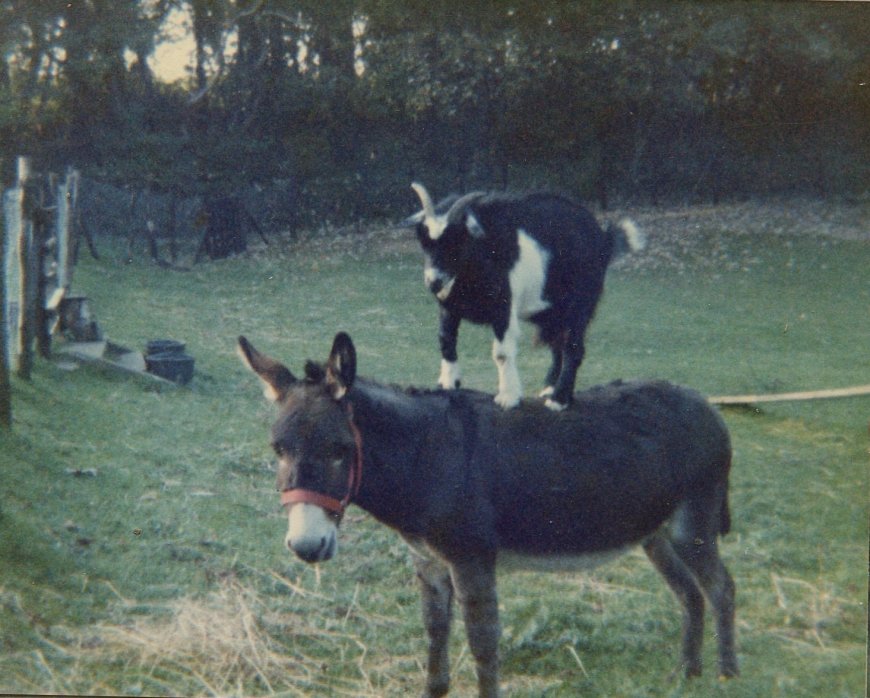
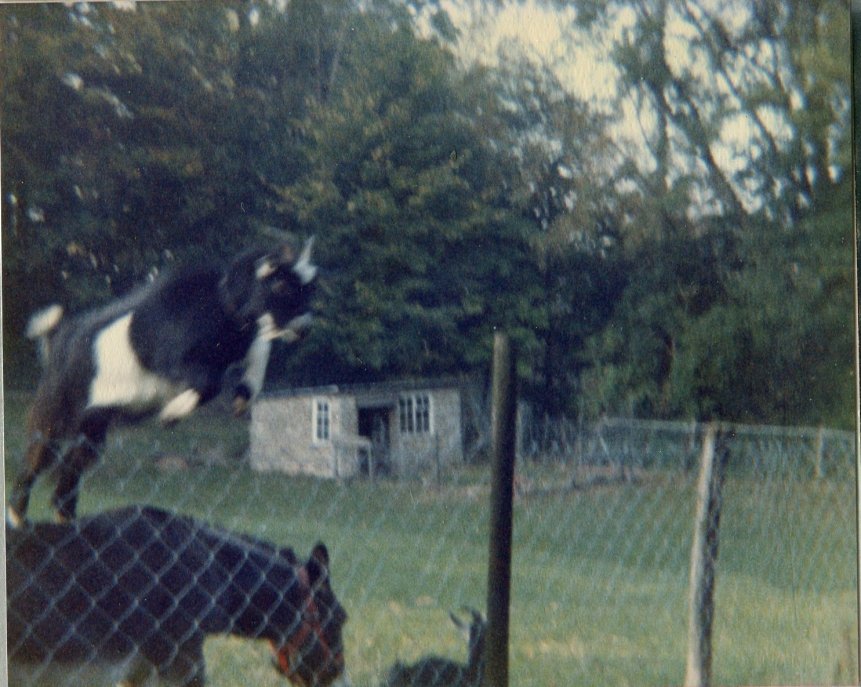
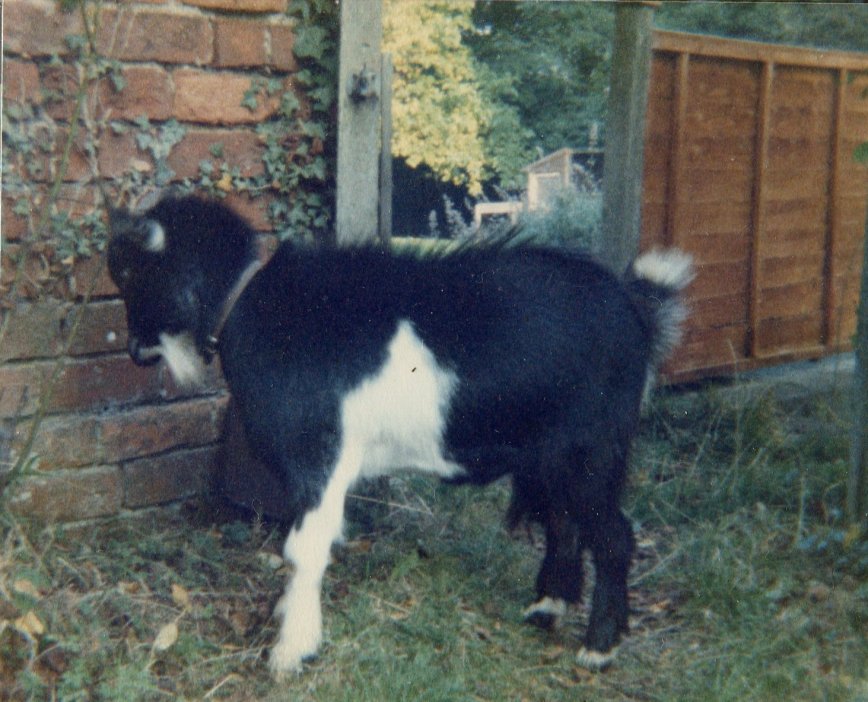
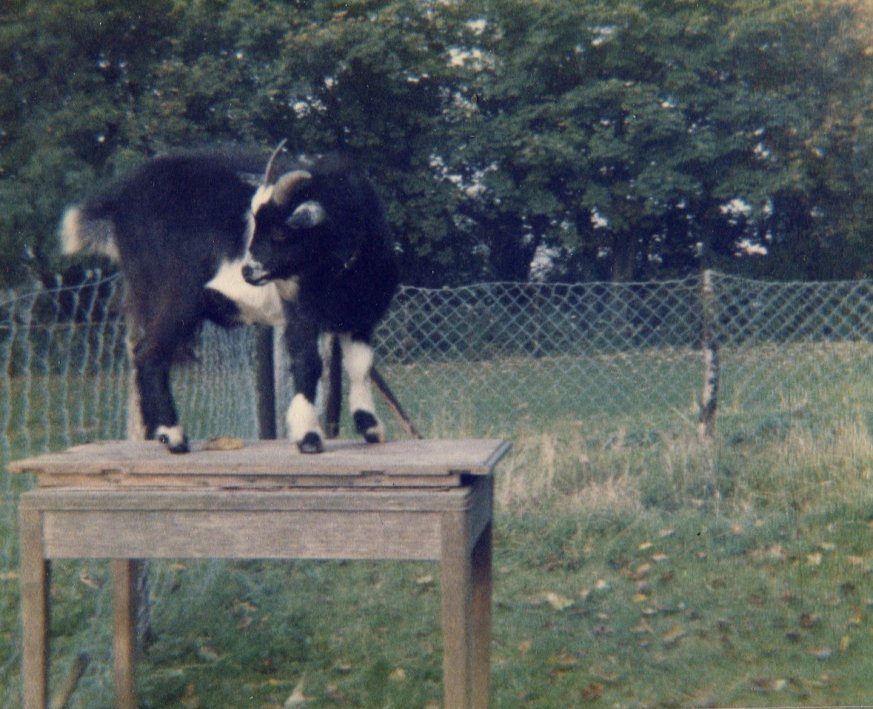
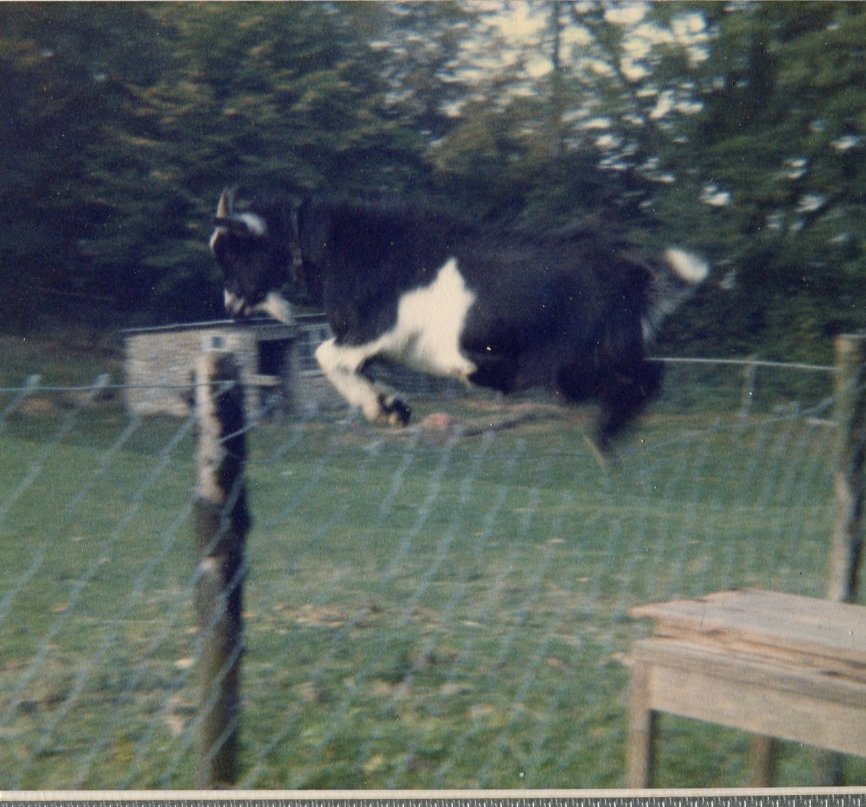
Stoney also bottle-fed young lambs for a local farmer before being returned. The last lamb, a male called Jovi, was allowed to stay and lived for 14 years before dying in 2011. At the beginning there were also chickens that in the winter were kept in the cellars. I remember ducks being kept in the courtyard area.
The first foal was owned by a tenant called Jane. The foal came from a visit to Stow Fair where the mare was going to be put down. So Jane saved the foal and it came to live at Hill House.
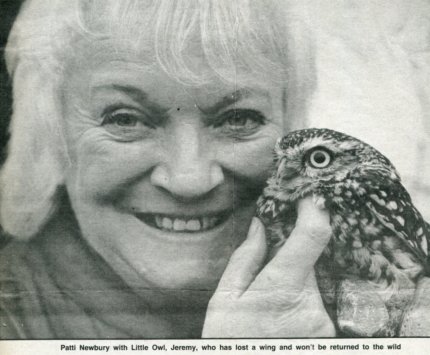
A major animal of her life was the fox Prils, which came from a friend, the late Patti Newbury. Patti worked in a vets and lived in Ryeworth Lane, Charlton Kings, where she looked after injured birds, mostly owls. A dog had brought home a small fox cub which then ended up at Patti's house to be looked after. She asked Stoney to have her for a month. This was before wildlife centres were established. Prils lived for 14 years, a great age for a fox. When still young, Stoney would carry her around town and to events to get her accustomed to people.
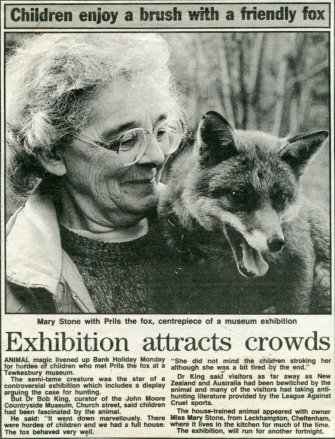
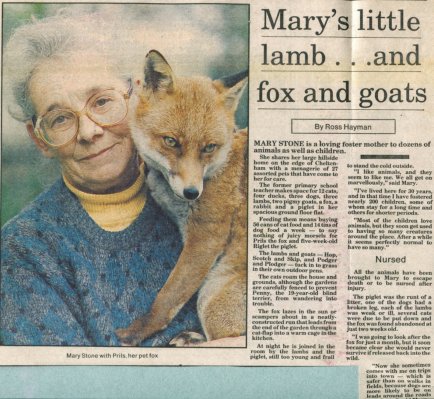
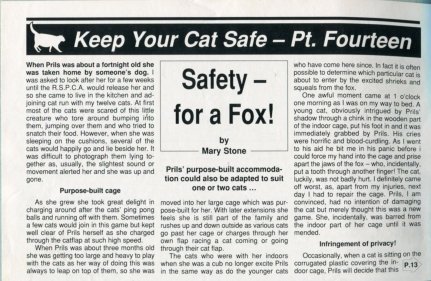
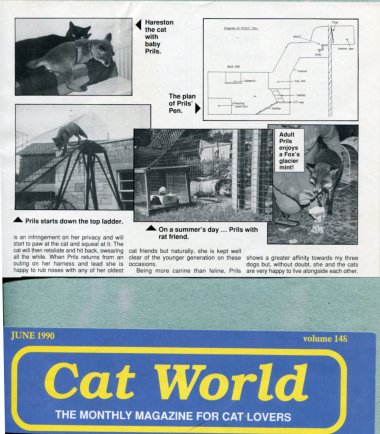
In the Gloucestershire Echo of 18 April 1990, there is a centre-page spread dedicated to Stoney and her 21 animals. Over the years Stoney was featured in a number of magazine articles and photos in various magazines. Other creatures included rabbits, rats, guinea pigs, chinchillas, mice, gerbils, mostly looked after as rescue animals or on short stay from friends, in essence, an animal sanctuary.
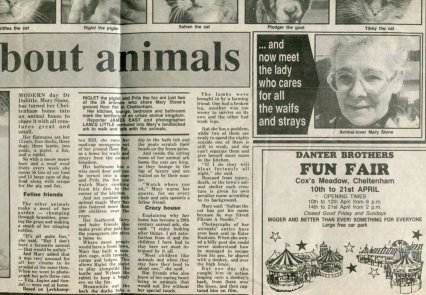
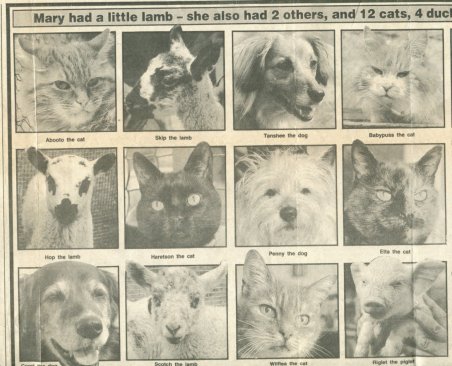
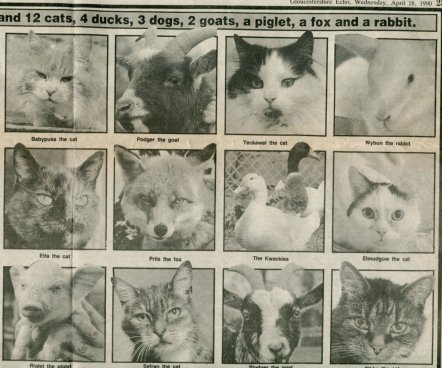
The 18 April 1990 article: The dog on the bottom left of the first sheet is Coret. The goat on second sheet is Plodger and the cat at the bottom right is Tibby.
This collecting of so many different types of animals created the need for a large amount of fencing for the corals, cages and runs outside, sometimes attached to windows of the house such as a cat run from the old kitchen window across the sunken courtyard to the old vegetable patch beyond. There were also smaller cages to be found inside. They were all made by Stoney who was quite adept and ingenious at cage making. She erected a large stone-built structure on part of the old tennis lawn, which she named 'The stable' and a wooden structure for the goats which she called 'The Goatel'. There was also a large caged platform supported by an old child's swing for the fox, which was connected to the kitchen via a tunnel.
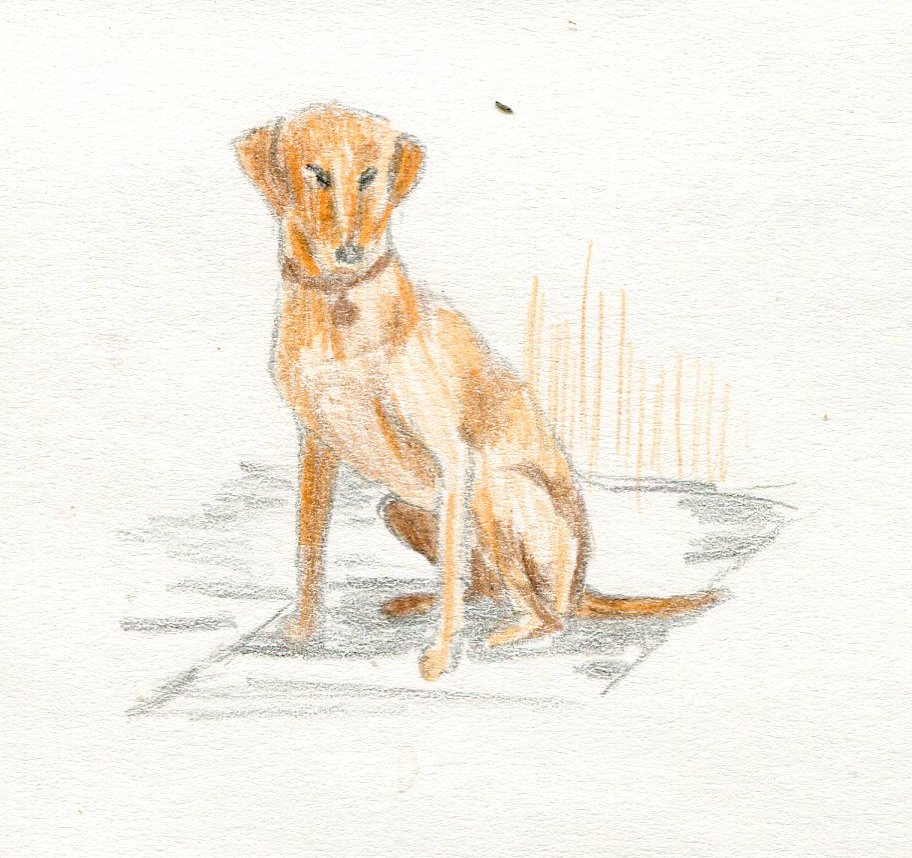
Misty or Coasty By Stoney
Talking cats and dogs
Another unusual characteristic of Stoney was her talking, and writing cats and dogs. Back in the mid 1950's while in her flat in Aldershot she wrote a story as if written by her cat Phouquey, called 'I Phouquey'.
I Phouquey
Another sheet about Phouquey:-
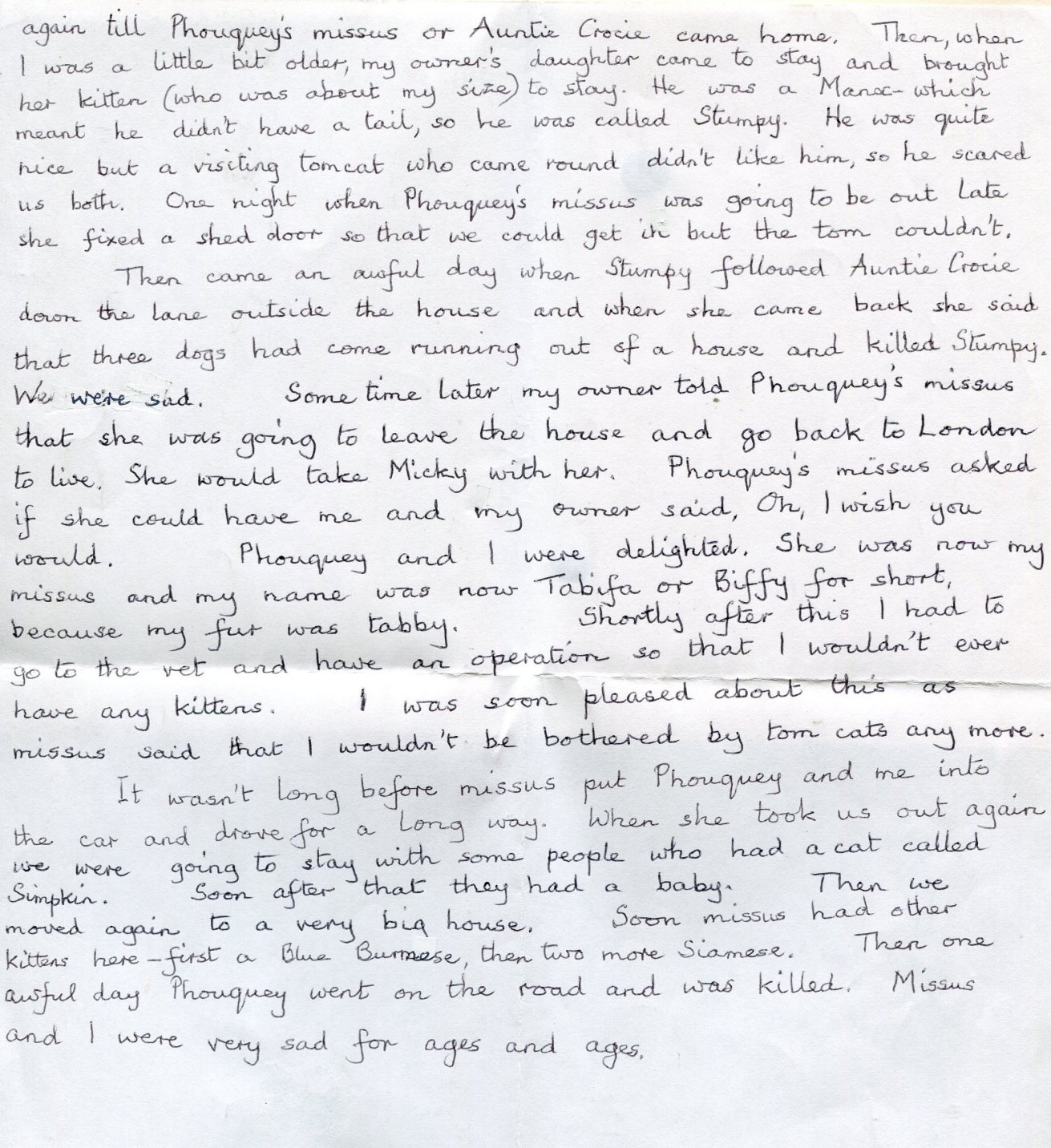
It had all started when she had to take Phouquey in the car to school because at the time, she couldn't leave Phouquey in the lodging house on her own. At first she left Phouquey in the car parked in the school playground, but after seeing the cat, the headmaster suggested that she could have it in the classroom. After several days meeting the children, Phouquey took to lying on a very high cupboard behind the blackboard and easel. When Stoney later moved into a flat and could leave Phouquey at home, the children complained so Stoney suggested that they should write to him, feeling that this could be a useful teaching aid. When Phouquey answered their letters, his writing was backwards as he had only 'viewed' Stoney's writing 'through' the blackboard from behind!
When Biffy came along she wrote another little story as if written by Biffy.
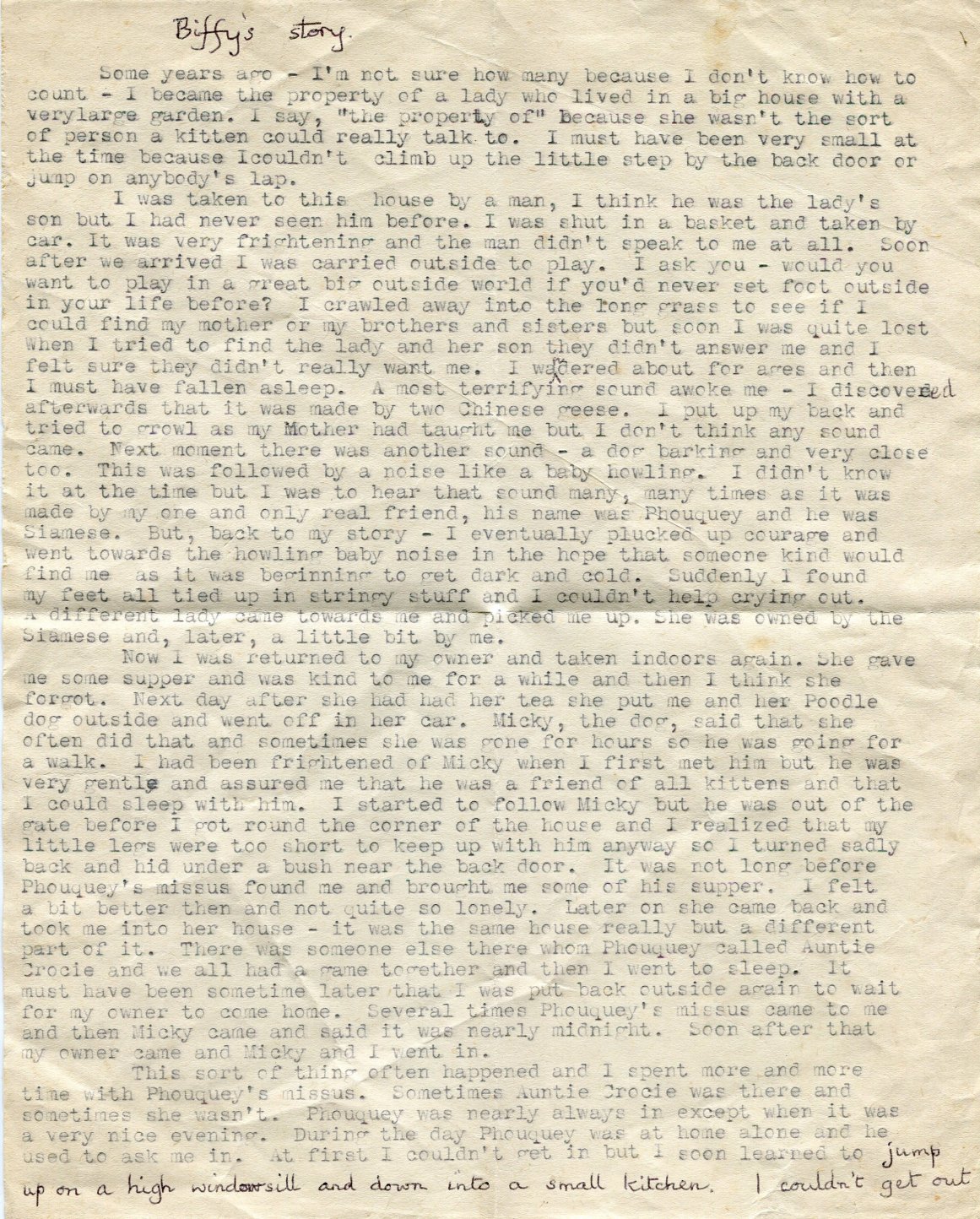
.
As long as I can remember, visitors would be confronted by Stoney talking in a strange, high pitched voice acting as if the cat in question was talking to you. It was always voiced in a simplistic form, usually starting with 'Oh hello, [whomever] how are you?', and then you would have to answer as if talking to the cat, if you didn't, it was considered rude and you would be told so. During my time most of the cats were kept in the kitchen and unsuspecting new visitors would invariably be led into the kitchen where they would have to perform, some people would not respond! According to Stoney only certain cats and dogs developed the ability.
Ossity Woozle was the first of these so called talking cats. He was born at Hill House from a stray called Suzie (changed to Suzie Woozle), The name Ossity came from an incident surrounding his birth. Suzie was jumping from table to table in the old kitchen and gave to birth to Ossity while she was jumping. Suzie had cat 'flu at the time and unfortunately gave it to her kittens. This meant they could not suckle, therefore Stoney had to feed them via a little tube. Ossity's little brother did not survive as he would not feed but Ossity did. Ossity got his name because he was a funny little thing and Stoney began to call him you funny little ---ossity'. Suzie was not a particularly good mother but Misty the dog was very friendly with him and he of course had Stoney so he had three mothers! He was very placid, gentle, friendly and very good natured cat and lived to be fourteen.
Over the years other cats would take on the mantle, Wiggers being the latest. It was not always cats, the dog Felby also talked but only to Stoney's friend Isobel, in this case in a somewhat panty tone.
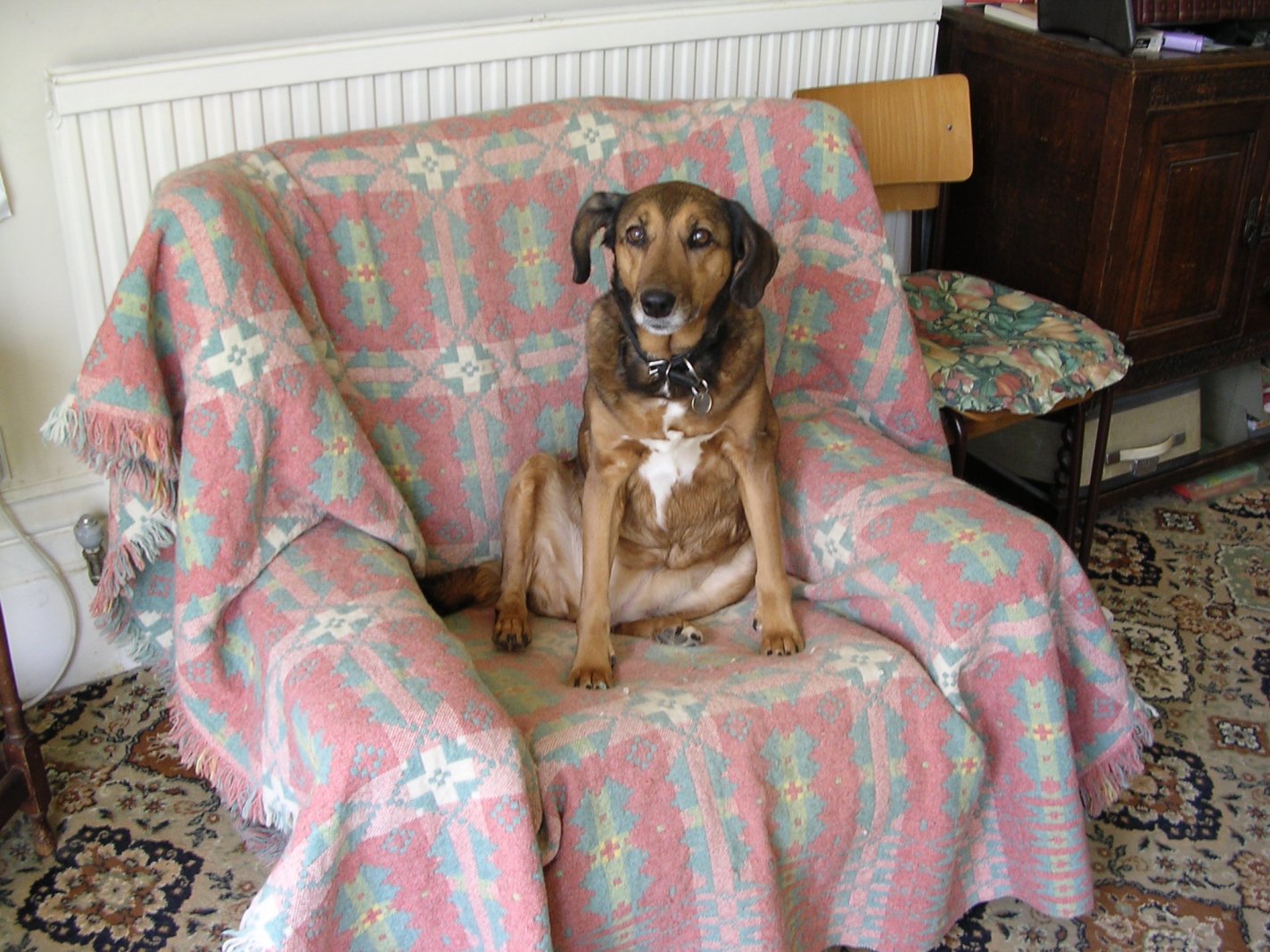
Felby
She transferred this writing skill to her cat Haretson by writing a little book titled 'Sir Ossity Woozle and All'.
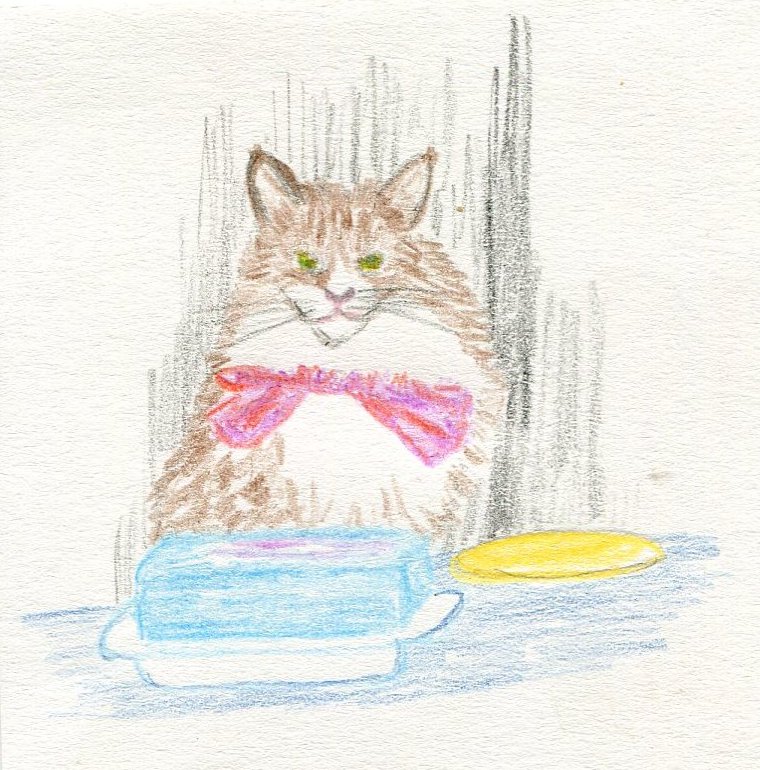
Ossity Woozle by Stoney
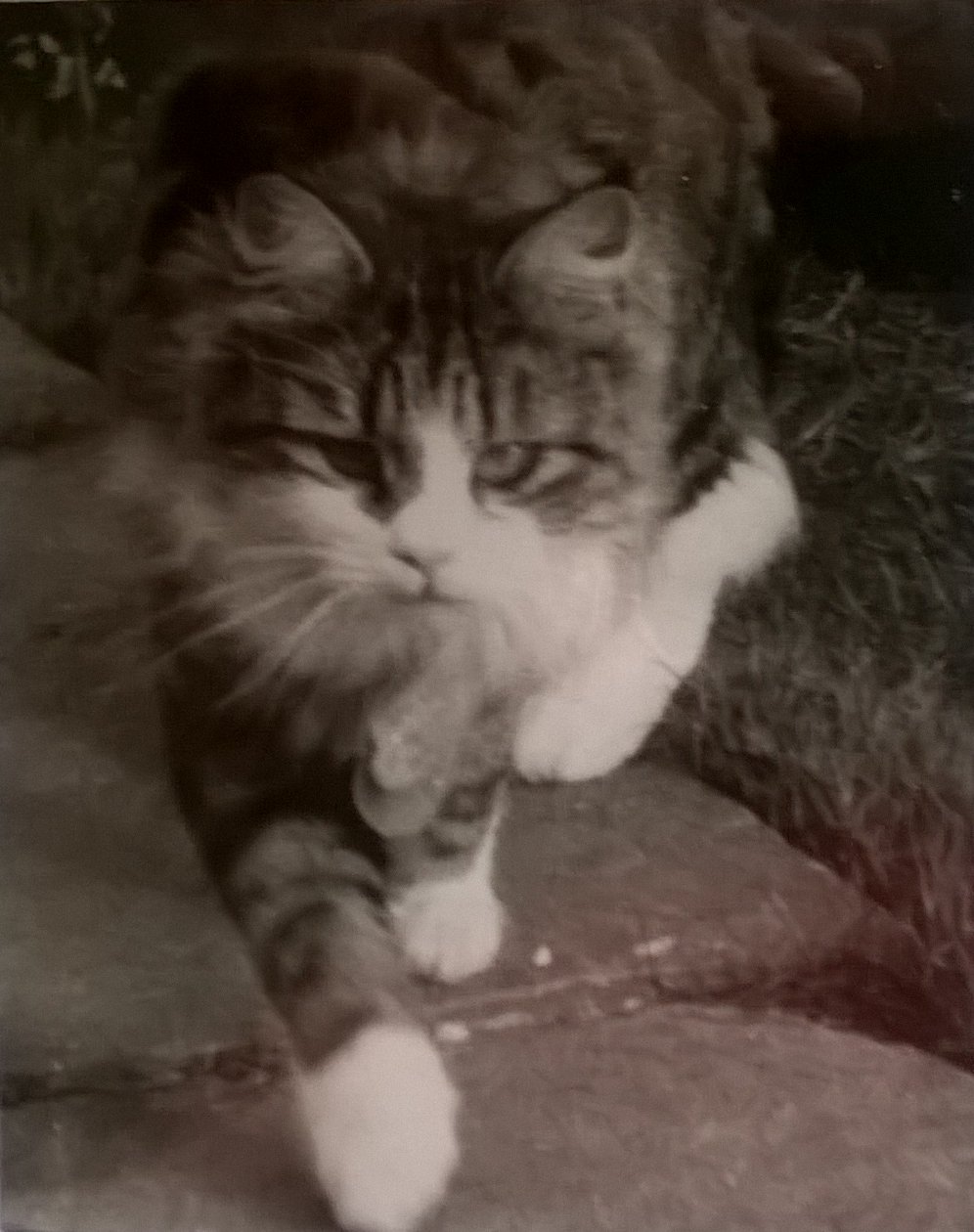
Ossity Woozle
The first is a notebook half of A5 in size and one has to start at the back of the book to read it. There are 79 pages of neat reversed writing where one has to hold the pages up to the light and read from the reverse side of the page. The pages have been reproduced below in pdf format, and also to enable one to read this charming little book, the images have been reversed. Her index of the animals mentioned in the book has also been reproduced.
elzooW ytissO riS, lla dna, yb, nosteraH
In reverse
Sir Ossity Woozle and All by Haretson
|
|
Index to animals mentioned in Ossity Woozle and All
|
Aba: 11,15,49
Achey: 38
Babypuss: 25, 44
Bass: 38, 57
Blip: 39
Brimpy: 39
Brindy: 36
Chadwhin: 17, 20, 69, 70
Coasty: 17, 31, 36
Coret: 31, 33, 34, 36
Etta: 10, 36, 45, 50, 53, 67
|
Fret: 10, 53
Frifow: 6, 8, 30, 53
Grueblin: 7, 53, 76
Haretson: 17, 31, 45, 50, 51, 52, 67, 75
Harry: 7, 45
Hoj: 58, 59
Jagens: 20, 23, 24, 49, 77
Kaleelah: 8, 28, 30, 53, 69, 70
Kenna: 52, 33, 34
Lucy: 29
Mavri: 36
|
McAnders: 16, 22
Mena: 38, 55, 57, 58
Mistletoe: 28, 33
Misty: 2, 35, 36, 56, 60
Muffin: 29
Ossity: 1, 6, 9, 43, 46, 43, 52, 53, 54, 55, 56, 61, 68, 69, 70, 73
Prils: 43
Podger: 37
Plodge: 37
Penny: 8, 9, 29, 61, 65, 66
|
Penny (dog): 34
Pharoah: 29
Pippy: 29
Phouquey: 5, 35, 78
Passo: 13, 28, 63
Pasda: 13, 28, 30, 61, 63
Rosemary: 37
Repha: 28
Safran: 11, 15, 26
Sandel: 19, 41, 44
Sinto: 39, 55, 59
|
Squib: 40
Susie: 29, 61, 63
Suzie: 1, 30
Tabern: 28, 30
Tabifa (or Biffy): 5, 35, 63
Tarje: 28, 30
Tahda: 11, 13, 53, 70
Tepi: 28, 30, 64, 65
Tibby: 29
Tonka: 40
Tosey: see Mistletoe
Treble: 38, 57
|

Stoney with a young Wignor taken about the year 2000.
The Ossity Woozle book was written over several years. Stoney cannot remember when the book was completed, but towards the end is the date 1986. Since the completion of Ossity Woozle and All, Stoney has continued with another notebook, which she is still writing. It continues on from Haretson's book, started by Haretson and has been continued by Wignor. Wignor takes over the writing of the book on page 37 and from then on the writing is in normal script. Therefore up to page 36, the book is in mirror writing. From page 37 onwards when Wignor takes over, the pages are in ordinary readable text.
rongiW & nosteraH [up to page 36]
In reverse
By Haretson & Wignor
|
|
Index to animals mentioned in Book Two.
|
CATS:-
Affuh: 33,34,38,43,44
Aba: 2, 47
Abboto: 4>/u>, 16
Babypuss: 3, 5
Bificops: 33, 16
Canagan: 38
Chaley: 27, 33, 38, 39, 42
Eta: 3
Elmudgow: 6, 8, 10, 11, 15, 17, 26, 33, 42
Frifow: 1
|
Haretson: 1, 3, 25
Jagins: 3, 25
Majuda: 26, 32, 33, 38, 39, 46
Mafuson: 26, 32, 35, 39, 46
McAndore: 3, 5, 20, 21
Safran: 2, 3, 47
Sandal: 3, 5
Spoguls: 38
Salve: 38
|
Teckawell: 5, 8, 11, 17, 18, 19, 25, 26, 32, 33, 45
Tibby: 13
Twankas: 34, 38, 44
Ugigi: 38, 44
Wignor: 37, 40, 52
Yasdi: 33, 34, 41
Vita: 3, 10, 25, 32
|
Wilflea: 11, 26, 33, 45
DOGS:-
Coret: 22, 36
Felby: 29, 31,36,39,46
Kelsa: 36
Kenna: 22
Penny: 22, 23, 36
Tanshee: 29
Tasy: 39, 49, 50
|
OTHER ANIMALS
Prils the fox: 17, 18, 36
Chipmunks: 30, 48
Chinchillas: 48
Lambs: 31
|
The Games
Stoney has always been a keen player of games both inside and out and many a good event took place on the back lawn, the old 'play Room' and after the house's conversion into flats, her living room. In her early days both at school and afterwards she enjoyed a variety of sports. She was a good runner and played tennis and cricket. She was also taught to play croquet by her father. At Hill House, volleyball and croquet were her favourite outside games and she usually beat her opponents.
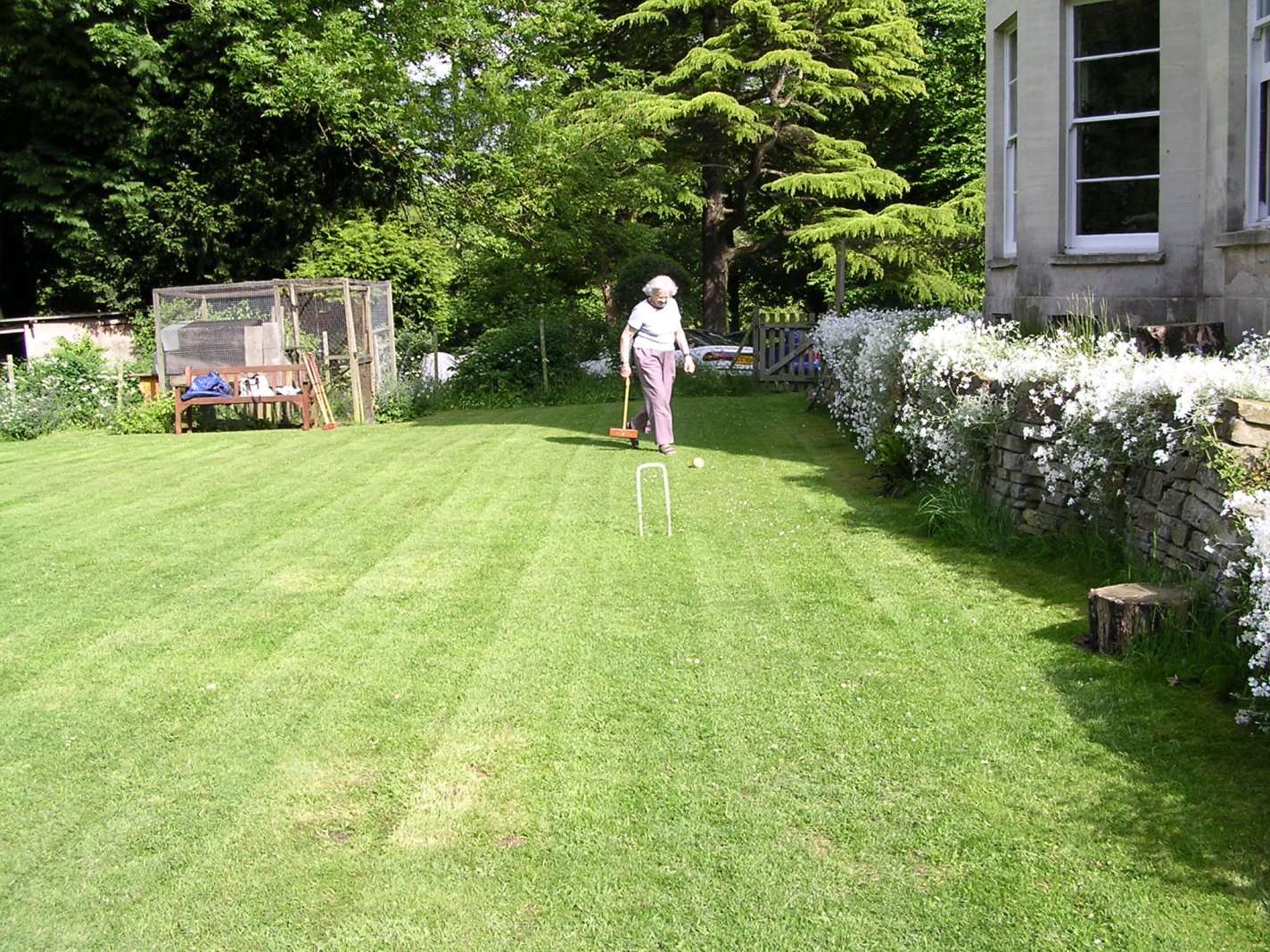
Stoney at croquet on the back lawn.
The lawn was ideally suited for a good croquet match and many were the time when I would be sent to the extremes of the lawn. She did try the Cheltenham Croquet Club in Old Bath Road but preferred the ad hoc and fun games at home. In recent years she has gradually given up outside activities, the last being croquet circa 2010.
Ping pong was played in the old kitchen, using old frying pans as bats on the kitchen table but it was the old drawing room with its beautiful parquet floor where indoor games usually took place. Snooker was played on a snooker table but there were many other games. She would often create games for the children and I imagine many a happy hour was enjoyed by children who may otherwise have had unfortunate lives, but that story is still to be told.
From about 1973 until at least 1979, the Playroom was the venue for parties. They generally took place on the weekend between Christmas and the New Year and involved both parents and children. The parties would start at 7pm and go on until 6am on the following morning. There was a different theme and each would involve a variety of games. Most of the events were devised by Stoney with help from Philip Weaving and the lists of the games and their themes for each year survive. The event that took place in 1977 was titled 'Kudja Dooso' by Onesty. The guests were divided into two groups and had to survive on two islands by finding food & water etc. and so the story developed, in this case with 41 games. One such game, developed by Philip and which took place most years, was by getting into pairs, sitting on the floor and making a frying pan out of a wire coat hanger and tin foil. The 'pan' was then used to cook an egg over a candle. The eggs were then eaten with bread rolls.
Stoney has been a teetotaller all her life and alcohol or getting drunk was frowned upon. During one of these Christmas games events, Patrick, Aldo and others sneaked some drinks into one of the closets in the house, and throughout the evening they were want to disappear from the Playroom and head for the closet. The result was a certain amount of unruly behaviour followed by illness. The following day there was a very unhappy Stoney!
Stoney used games a lot in her teaching, believing that children were more susceptible to learning if they were enjoying the activity. Over many years she would use board games, which she adapted, to teach children basic reading and arithmetic. This was her forte and a very successful one. She would change a game's rules to make it simpler or harder to enhance the player's interest and ability. She was a support teacher at Coberley primary School for many years, only having to give up about three years ago. She would also have children at home for an hour or so, albeit on a private basis.
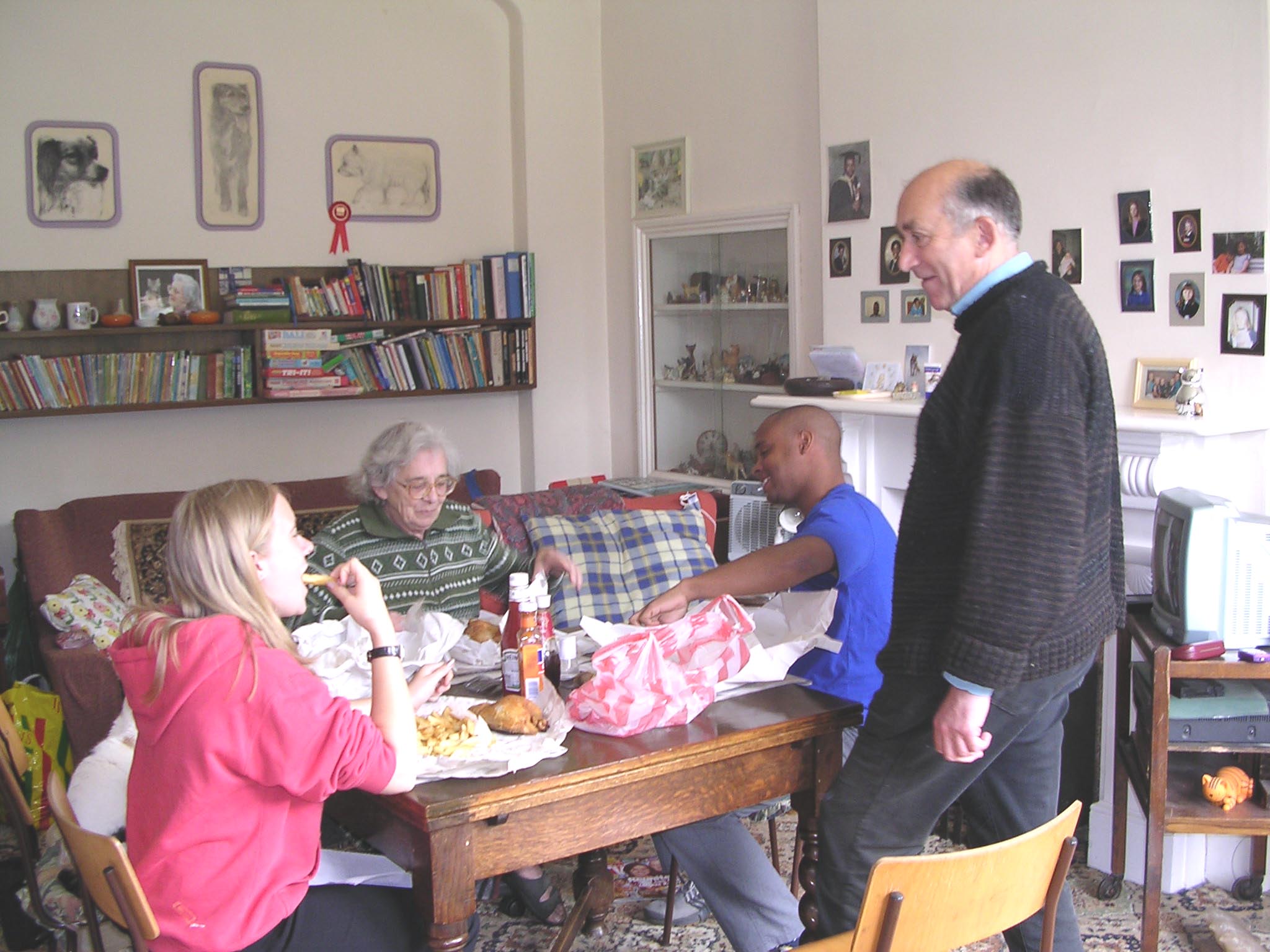
A typical fish and chip session.
The people on this occasion were Rowena, my daughter, Stoney, Jeffrey and Aldo.
Over the years there were other nights but Saturday nights were the most memorable, starting about 8pm in Stoney's living room and almost always starting with a frenetic card game called racing demons. When I was there from about 2000 onwards, the main participants or guests were Aldo Shepherd, who lived just in to Greenway Lane, Keeley, my step daughter, Len, Philip Hermes, Jeffrey and Patrick Yates. The other main game was Strawberries, a game based on, and much better then, scrabble but there were other games both card and board. Another delightful game was Detour, a game with little wooden cars on an ever changing road system. It was created by Stoney with help from Aldo and Patrick. She tried to patent it and a gaming company did take it on but changed the game drastically and to our minds in the wrong direction and they subsequently failed to sell it. Favourite card games were 'Find the Lady' and 'Spite and Malice'. Games were not serious and on the whole funny, chosen for their simplicity with a child-like non serious slant.
The Tenants
Between 1960 and the present, it is believed there must have been over three hundred tenants at Hill House. In her foster child days, before the house was converted into flats, the top floor along with the little flat over the old kitchen, was given over to tenants. Stoney's bedroom was on the first floor room looking out at Leckhampton Hill. The remaining rooms on this floor were given over to children etc. The first tenants were a couple. The man possessed a toupee and one day Phouquey was seen running down stairs with it, closely followed by the man.
In the mid 1980's, when Stoney gave up fostering, she had the house converted into Flats. This caused a great upheaval to the property and many changes took place. The top floor with its four large rooms and great landing was divided into two flats. The fifth was the small flat over the old kitchen. The sixth was on the ground floor, which was changed dramatically to create one large flat while Stoney had the old study, the cook's old bedroom along with the old butler's pantry and the old kitchen and adjacent room which were divided into three small rooms and a shower room. It was either at this time or before that someone saw the ghost of a grey lady on the bend of the top flight of stairs.
Friends
One of her oldest friends was Muriel Kimberley, a school friend at the Convent in Charlton King's. Like Stoney, Muriel became a teacher, although she wasn't particularly keen on children. She did marry but her husband died. When I first got to know her in the 1990's, she lived in Barnstaple and then in the mid 2000's she moved to Exeter. Muriel comes to stay for several days every year or so and takes part in the board and card games and when not gaming, she does crossword puzzles.
Over the years Stoney has had many friends, both male and female, the late Isobel who lived in Coberley springs to mind, and Joy, another school mate of Muriel, who visits every week. Reg, who lives in Langdon Road, who helped in the garden for many years. Patrick, who was originally one of Stoney's foster children, has, off and on, lived at Hill House and helped look after Stoney.
There is a lady called Jane who lived at Hill house for about 11 years in the flat above the kitchen and now lives at the farm above Coberley.
The Children
Back in 1960 or thereabouts, Stoney acquired permission from the local Social Services to foster children, as someone who would take on short-term children during holidays etc. At the same time she also took on children privately. The first child she acquired was a 12 year old boy. He came via the headmaster of her old school in Sussex where she was a matron for 4 years. From the Social Services she took 3 children, a boy and girl twins, along with a younger 7 year old girl out of a family of five. The mother had been found dead and the father was in prison. Despite it being the middle of winter, they arrived in thin summer clothes and insisted in sleeping in the same bed. They were subsequently housed in a childrens home in Cirencester.
Stoney then asked Social Services for children on a more permanent basis and immediately received three children called Peter, Philip and Diane, they stayed for several years. Their mother had taken them into a shop, told them she was just going out for a minute and never went back. There were also two children, girls Christine 12 and Ann 13. Diane, who has been happily married for many years, is still in contact with Stoney.
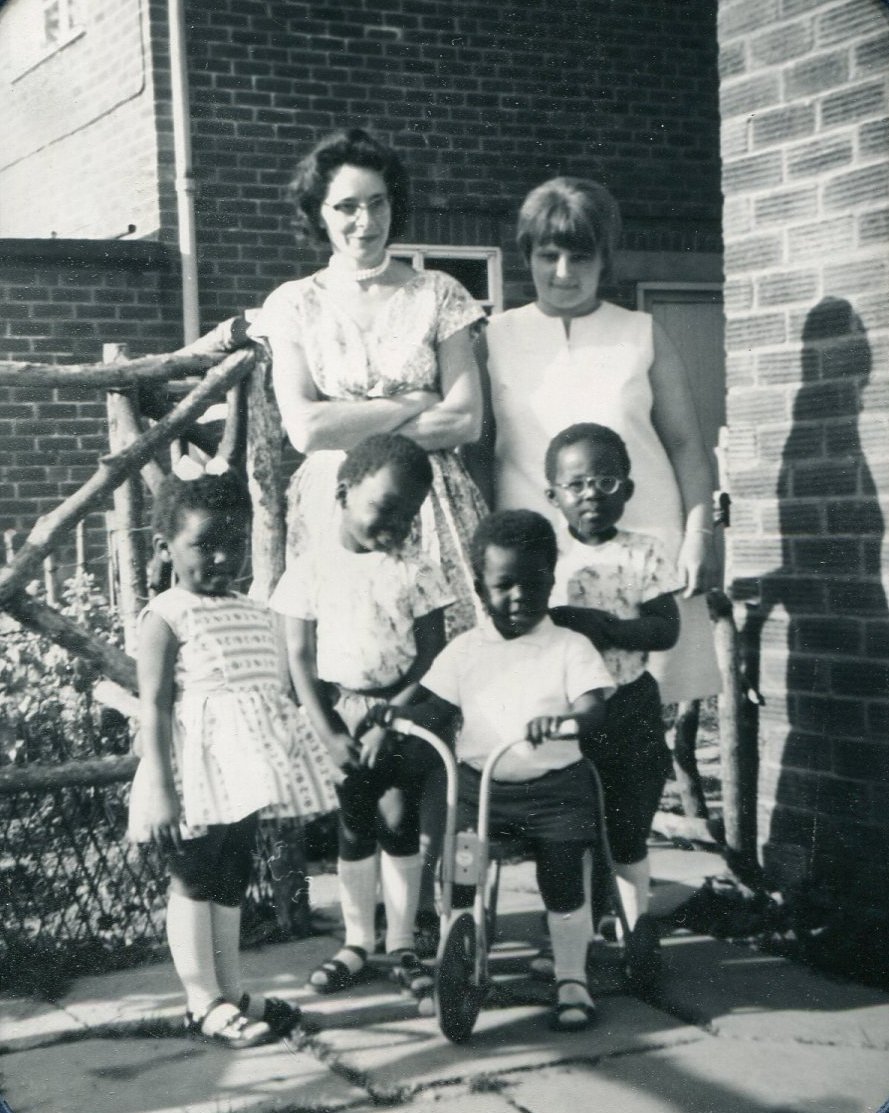
Stoney with children Ann Wasaluski[?], a Polish girl
and four of her children: Jackie, Philip, Akin & Dele.
Stoney also answered adverts in 'The Nursery World' and acquired younger children, mostly from Africa, whose parents were studying in this country. Two baby boys came within a week, Dele from Nigeria aged 3 months, and two days later she went to London to collect Philip from Sierra Leone aged 2½ months. Eighteen months later she took Dele to London for his brother's christening and was told that she could also take him, he was called Akin. Three years later along came 3 year old Jackie, from Uganda. Jackie grew up at Hill House and now lives and works in Luxembourg. Jackie, along with all the children, went to school at Leckhampton Primary School. Amongst Jackie's friends was a Jackie Roberts who lived in Daisybank Lane just where it turns into a dirt road. Another little girl called Caroline, came via Jackie's uncle, a dentist in London.
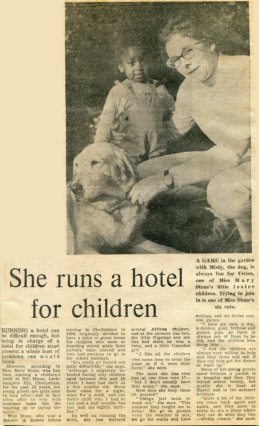
Early photographs show 14 children from various backgrounds, some short and some long term. Stoney believes that in all there must have been over 200 ranging from 1 month to 18 years. She still keeps in contact with some.
At one point while Stoney had one baby, she was asked by the Social Services if she could take 5 children, which gave her 10 children in all under the age of 10 years. They came from Worcester Social Services for a fortnight. She said yes provided she had help. On the day, the help didn't turn up so with the help of Margaret she looked after them herself. The mother of five of them was booked in to be sterilised!
Janet McLaren came to Hill House along with her sister Ann during the school holidays in the 1970's. She now lives in one of the flats, and manages the house for Stoney. Along with Janet and her sister Ann, there were the Weavings, Philip and Peter. Janet was later to marry Philip. Philip now lives in America and Peter lives with his family in Cheltenham. Two frequent visitors at this time were children Neal and Craig from Tramway Cottage in Daisybank Lane.
Later came Vivien, Genevieve and Oscar Ssentoogos from Uganda. Vivien was aged 14 months, she later went back to Uganda but returned to join Jeffrey and June. She became very good on Stoney's piano and now lives in London. Jeffrey stayed until he was 10 and then returned to Sierra Leone to live with his father. June was one of three sisters from Sierra Leone.
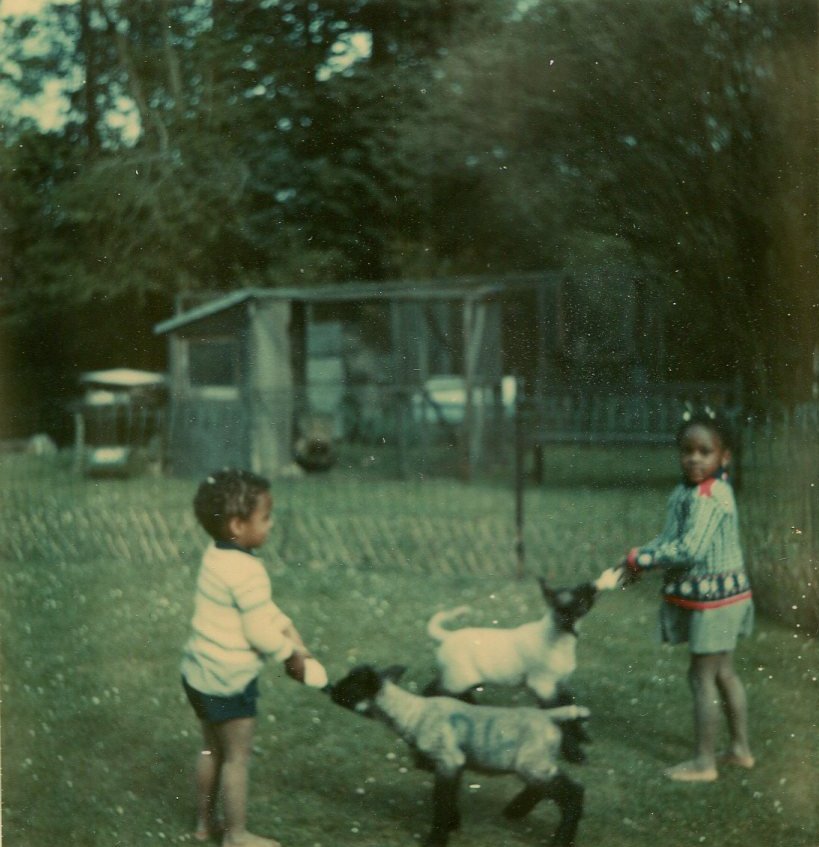
Jeffrey and June feeding the lambs on the back lawn in 1976.
Jeffrey came from Sierra Leone, his mother, who was Scottish, had left him with his father. His father, who knew Philip's mother, sought out Stoney and Jeffrey grew up at Hill House and is still a visitor.
Stoney
During the last 50 years with all the animals, foster children, tenants and friends, she has amassed a huge network of acquaintances and characters. Consequently Hill House has become a kind of hub to a large number of disparate people and although Stoney is now not so mobile, many of the games have ceased and Janet takes care of the tenants, she still receives visitors both on a regular and irregular basis, still a queen of her world.
Stoney was a stern task master with children, animals, and friends, and what she said went. As a child she was afraid of water and would not go in a boat, neither did she like heights. When young Stoney had been house cook for a while, but she had little interest in cooking so the fare of both her and the children was basic, nevertheless Hill House was a haven and home to many, where there were games, security and laughter.
During the many years that Stoney and I have known each other, I would like to think that a mutual fondness and respect has grown up between us. I had an unusual upbringing with an eccentric mother surrounded by misfits and at one time 15 cats, 8 dogs, a jackdaw who ate bread, a thrush who ate mealworms and a spider monkey which who carried around Cheltenham with a nappy like a baby. So I suppose Stoney's world was a kind of haven to me as well, albeit later in my life and it must have been so for many others. There was always something going on especially with so many characters involved and Stoney somehow acted, even now, as a kind of kingpin holding it all together.
Julian Rawes, Harvington, August 2013.
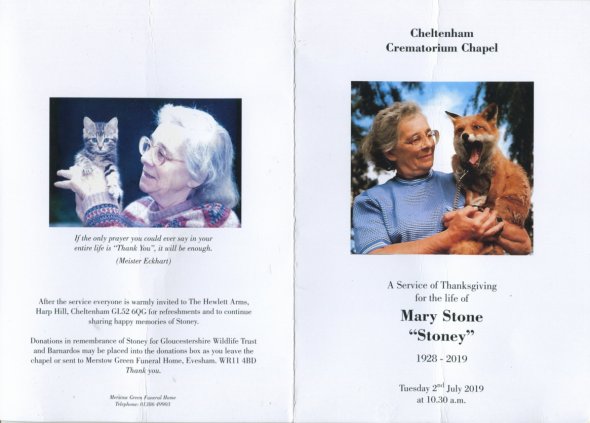
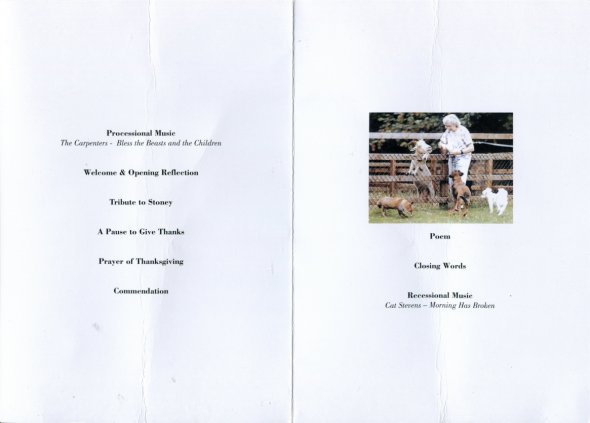
APPENDIX
Communication with Michael Richards of New South Wales, Australia in 2024.
On 25/09/2024 06:22, Michael wrote:-
Hello Julian
I came across your account of Mary Stone online while researching my own family history and was glad to find out more about her. I am the eldest son of the Ď Gillí you refer to in your account of Mary's step-mother, Blanche Lloyd. In relation to Gillís history (she was christened Gillian and was usually called Gill, but after leaving England in 1948 used her second name Anne), her father Sidney Arthur Billes died in Calcutta in 1931, and her mother Gwen remarried in 1935. Her second husband was Warrant Officer Joseph James (Jimmy) Tucker, a member of the Indian Army Ordnance Corps, and later Major Tucker.
So Iím very interested in the photo you have on your website captioned ĎGill and Eve eating apples with their step father Ö 1946í, as I have nothing showing my step-grandfather from that time in his life. He had survived being a POW at Changi and on the Burma Railroad, and spent several more years in the army in India before migrating to South Africa - but he actually died in Cheltenham, to which he and Gwen returned after a few years in Brisbane. My mother lived in South Africa until 1959, during which her first four children were born. We then migrated to New Zealand before settling in Australia in 1967, where she raised two more children. She died in 2021, at the age of 92. Her sister Lyn (originally Evelyn) lives in Canada, where she has long been settled.
Incidentally, my mother revisited Mary in 1987 during a brief return to England after forty years away, and I met her myself a couple of years earlier - I lived in England for six years in the 1980s. Mum stayed in touch with her throughout her life and liked her a lot. Mary was indeed a remarkable person, and I imagine your post about her has been widely read.
You might be interested in my motherís account of her visit to Mary in 1987:-
In Cheltenham, I stayed with Mary Stone, at Hill House on Leckhampton Hill. Hill House is an Edwardian house which Mary has had divided into flats, while she has the ground floor for herself and her animals. In 1987, she had three dogs, eleven cats, two goats, two rabbits and a fox, but only the dogs and cats were inside. Mary has always been very fond of animals, and most of them have come to her because nobody wanted them. One of the dogs, a little white terrier named Penny, was blind, and the fox was rescued when its mother was killed. The next day we went into town and I was surprised to find how much I remembered. In the afternoon, we walked all around Maryís domain and had a good view of Cheltenham from one of the fields.
On Thursday we went to Stow-on-the-Wold (where the devil caught cold!), to see the Spring Fayre there. ... From there we went to Andoversford, where Mary and I had lived before the war. We parked the car in the village and walked up the drive as far as the house, then we took some photos of Owdeswell, although it was still raining. Back to Cheltenham for lunch and in the afternoon, I walked down to the De Lancey Hospital to see Aunt Ivy briefly. Later, Julie phoned from Gloucester, she wanted me to go there for dinner and maybe make a quick trip into Wales, ancestor hunting, which would have been good. The next day I went into town again and bought a hat Ö. I went to a shop I remembered in the High Street, Madame Beatrice Taylorís, where the elderly assistant was sure she knew my face! After forty years! The hat was made of pink straw and she found a flower to go on it which matched my dress. She also tried to match me up with a middle-aged gentleman who came into the shop seeking his wife!
After lunch, Mary and I drove over to Malvern and on to Colwell, where we found Queenswood. No longer a school, it is now a private house, and the new wing is a separate house called Little Queenswood. Then we went to the church we had attended, St. James the Great, and were surprised by the distance we had walked as schoolgirls, three times every Sunday after we had been confirmed. The next day I went to Gloucester and had lunch with Julie and Betty Lloyd. On Sunday, Mary went with two of her ex-foster children, Philip and Genevieve, to the christening of the child of another foster-child. I went to the cemetery but was not very successfully, I only found the plaques which commemorate Mum and Dad, and which I knew would be removed in the not-too-distant future.
Regards, and I look forward to hearing from you.
|
|